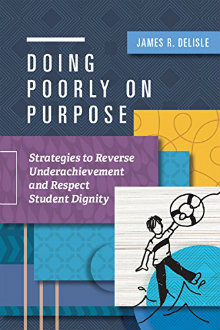Helping Students Who Do Poorly on Purpose
Doing Poorly on Purpose: Strategies to Reverse Underachievement and Respect Student Dignity
By James R. Delisle
(ASCD and Free Spirit Publishing, 2018 – Learn more)

Doing Poorly on Purpose explores how to help smart students who do poorly in school, but many of the ideas can be used with any student.
The word “dignity” appears in the subtitle of this book. Author James Delisle explains “that if smart students don’t feel they are getting it from those in charge of their learning, then their desire to conform and achieve is being minimized.”
He further explains “that by asking students to do work that is below their ability, we ignore the very qualities that got them identified as intelligent in the first place.” Teachers need to ask themselves, “Where’s the dignity in that?”
Children first want to know that an adult cares about them and not just about the grades they get in school. The book uses two students – Sierra, a fifth grader, and Marty, a seventh grader – and introduces them using the terms underachiever and selective customer. There is a key difference between these two students and the terms used to describe them.

Marty, the selective customer, on the other hand does not need teacher support or guidance. He will pity the teachers that are not smart enough to realize how bright he is and how well he can do work. Marty is happy to tell teachers he got a low grade because the assignment was lame.
Reaching underachievers and selective customers
One approach discussed to help both Sierra and Marty is called Curriculum Compacting. It is explained as “the process of assessing student knowledge of basic skills and eliminating or minimizing ‘practice’ of those skills,” which opens up time in the school day to explore more advanced or enriching topics. Teachers often don’t want to allow students like Marty to have the opportunity to explore things he is interested in when he does not want to complete basic class assignments. However, this method tells Marty that you know he is skilled in some content areas. It allows success for both the teacher and student. It also allows students like Marty to help design their own education, so the assignment can’t be described as lame.
Another option Delisle explores is encouraging students to participate in learning activities that take them outside the classroom for exploration. It is important for teachers to invite students to bring their worlds into our schools. One example on how to do this is the National History Day project (https://www.nhd.org). Other similar options are also available, and they engage students in high-level research or elaborate study.
Building self-advocacy
Both of these options can lead to “self-advocacy” on the part of students. Students like Sierra and Marty often feel that school is something done to them, not with them. Deb Douglas, a long-time coordinator for gifted programs offers four principles she shares with students so they can become active participants to change education. Among them are Step 1: Understand your rights and responsibilities as a student; Step 2: Assess and reflect on your learner profile; Step 3: Match your attributes to options and opportunities; and Step 4: Connect with advocates who can support your goals. This is a great way for teachers to start the school year with students.
Students themselves often need help in approaching a teacher. There is a special section in the book that includes “Ten Tips for Talking to Teachers.” Probably the most helpful thing that a teacher can do is to show students that mistakes can sometimes turn into great accomplishments. Some of your students’ favorite things were developed by accident – cheese, chocolate chip cookies, and sticky notes. They need to know they are allowed to make mistakes.
Elizabeth OBrien has worked for the Department of Education in New York City in many different teaching roles. Her main desire as an educator has been to allow children to explore and discover by giving them the right guiding tools. Her favorite quote from Albert Einstein is “The true sign of intelligence is not knowledge but imagination.”

































